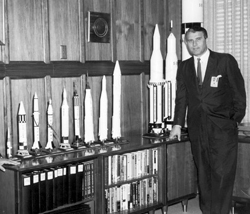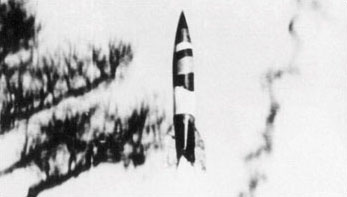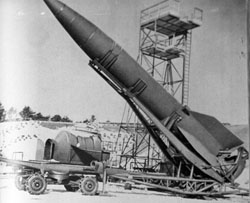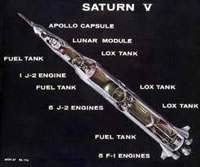(1) Since immemorial times, when the first human being looked up to the sky, the challenge was already outlined, but it was only in 1969 A.D. that man set foot on another celestial body. The journey to the Moon and planets is in the heart and soul of all human beings, but it is not in our direct, near-term interest of everyday life. It required singular events, people and conjuncture to become real.

(2) A project like Space Travel is nothing like a garage work performed by a single person working in secrecy over many years. It requires huge resources and people passionately involved to carry the immense difficulties in the political, financial, managerial and technical arenas. Wernher von Braun was the personality that could circulate among all these channels, interacting and creating synergy among technicians and scientists, getting presidential support and interested businessmen that would be engaged in sending man to space. He was an exceptional engineer, a prominent salesman for the cause of space exploration, a skillful political amalgamator that conciliated all the views in one direction, a profuse writer and divulgator of space travel among the general public, an enormously successful fund raiser for space projects and ‘the personality’ that could be identified with space exploration. In other words, he was a crusader for space travel all the way.
(3) Wernher von Braun was born on March 23, 1912 in Wyrzysk, Wielkopolska, in the German Kingdom of Prussia. He was the second of three sons with an impressive pedigree1генеалогия. His father, the conservative politician Magnus Freiherr von Braun, served as a Minister of Agriculture in the Federal Cabinet during the Weimar Republic. His mother, Emmy von Quistorp could trace ancestry through both her parents to medieval European royalty. Wernher von Braun decided at 10 years of age that he would "turn the wheel of time." Among other projects, he composed music, wrote poetry, and built an automobile out of old parts. In fact, he spent so much time building his car that he flunked mathematics and physics. After reading Hermann Oberth's "Rocket into Interplanetary Space" and receiving a telescope from his mother, he decided to become a space pioneer and physicist. At the age of 13, von Braun got in trouble again when he obtained six skyrockets, strapped them to a toy red wagon and set them off. Streaming flames and a long trail of smoke, the wagon roared five blocks into the center of town, where the rockets then exploded. Also he drew a sketch of a space ship he hoped to make someday that would take men to the moon and beyond.
(4) The next step for the eighteen-year-old Wernher von Braun was to enter the Institute of Technology (Technische Hochschule)2высшее техническое училище in the Berlin district of Charlottenburg. Von Braun quickly joined the Society of Space Travel (VfR, Verein für Raumschiffahrt) and was soon participating in rocket experiments. But in 1932 Adolf Hitler was in power. Nazi Germany was going to ban all rocketry experiments and discussion - outside of the German military. On November 1, 1932, von Braun signed a contract with the Reichswehr to conduct research leading to the development of rockets as military weapons. In this capacity, he would work for Captain Walter Dornberger. His association with Dornberger would last for over a decade. In the same year, under an Army grant, von Braun enrolled at the Friedrich-Wilhelm University from where he graduated two years later with a Ph.D. in physics. His dissertation dealt with the theoretical and practical problems of liquid propellant rocket engines3жидкостный ракетный двигатель.
(5) Even before he graduated, von Braun was busy conducting his first rocket tests at Kummersdorf, an old Army artillery range outside of Berlin. A few of von Braun's colleagues from the VfR days joined him and started work on what would be called the A-1 rocket. The A-1 would eventually evolve into the A-2 and A-3. These rockets were successfully tested off the coast of Germany in the North Sea. By 1935, von Braun and his team, which had grown to eighty members, were regularly firing liquid-fueled engines with great success. Throughout his time at Kummersdorf Von Braun showed that he was a team leader; he didn't work alone, but encouraged those who worked for him to accomplish their best. He was also able to assimilate large amounts of data, literature, and technical drawings while keeping the big picture always in his mind.
(6) Dornberger held a public test of the A-2 which was greatly successful. Both the Luftwaffe and the Wehrmacht fought over who could give von Braun's rocket team more money. On December 22, 1942, Adolf Hitler signed the order approving the production of the A-4 as a "vengeance weapon"4оружие возмездия and the group developed it to target London. SS General Hans Kammler, who as an engineer had constructed several concentration camps including Auschwitz, had a reputation for brutality and had originated the idea of using concentration camp prisoners as slave laborers in the V-2 rocket program. More people died building the V-2 rockets than were killed by it as a weapon. Von Braun admitted visiting the plant at Mittelwerk on many occasions, and numerous quotes from von Braun show he was aware of the conditions, but felt completely unable to change them.


(7) Things were not always good for von Braun. The SS and the Gestapo had detained von Braun and arrested him for crimes against the state because he dared to talk about building rockets which would go into orbit around the Earth and perhaps even someday go to the Moon. Von Braun's rocket team had plans on their design review boards of even larger rockets with a potential for orbital flight. The A-9 and A-10 were to be the world's first multistage rockets with first stage thrusts of 400,000 pounds and ranges of over 3000 miles. The A-11 was designed to launch a pilot or a satellite into orbit while an A-12 had the capability of launching a payload of 11 tons into high Earth orbit, a feat that rocketry finds challenging today. His crime against the state was for the frivolity of these dreams rather than total concentration of building military rockets for the Nazi war machine. Dornberger convinced the SS and the Gestapo that without von Braun there would be no V-2 and that Hitler would have them all shot. Thus the Gestapo released von Braun.
(8) Knowing that Germany was doomed, von Braun, upon arriving back at Peenemunde, immediately assembled his rocket team and asked them to decide to whom they wanted to surrender. The Russians frightened most of the scientists; the French would treat them like slaves; the British did not have enough money to afford a rocket program; that left the Americans. After stealing a train with forged papers, von Braun led 500 people through war-torn Germany to surrender to the Americans while the SS had orders to kill the German engineers who built the V-2. Hiding their notes in a mine shaft, the German scientists evaded the SS in search for American soldiers. Finally, the entire German rocket team found an American private and surrendered to him. The Americans immediately went to Peenemunde and Nordhausen, captured all of the remaining V-2s and V-2 parts before the Russians arrived.

(9) For fifteen years after World War II, von Braun worked with the U.S. Army in the development of ballistic missiles. As part of a military operation called Project Paperclip, he and his rocket team were scooped up from defeated Germany and sent to America where they were installed at Fort Bliss, Texas. Since they were not permitted to leave Fort Bliss without military escort, von Braun and his colleagues began to refer to themselves only half-jokingly as "PoPs", "Prisoners of Peace". There they worked on rockets for the U.S. Army, launching them at White Sands Proving Ground, New Mexico. In 1950 von Braun’s team moved to the Redstone Arsenal near Huntsville, Ala., where they built the Army’s Jupiter ballistic missile.
(10) As Director of the Development Operations Division5научно-исследовательский и опытно-конструкторский отдел of the Army Ballistic Missile Agency (ABMA)6управление БР СВ, von Braun, with his team, then developed the Jupiter-C, a modified Redstone rocket. The Jupiter-C successfully launched the West's first satellite, Explorer 1, on January 31, 1958. This event signaled the birth of America's space program.

(11) In 1960, his rocket development center transferred from the Army to the newly established NASA and received a mandate to build the giant Saturn rockets. Accordingly, von Braun became the director of NASA’s Marshall Space Flight Center and the chief architect of the Saturn V launch vehicle, the superbooster that would propel Americans to the Moon. His dream to help mankind set foot on the Moon became a reality on July 16, 1969 when a Marshall-developed Saturn V rocket launched the crew of Apollo 11 on its historic eight-day mission. Over the course of the program, Saturn V rockets enabled six teams of astronauts to reach the surface of the Moon.

(12) Von Braun - while directing military rocket development in the real world - continued to entertain his engineer-scientist's dream of a future world in which rockets would be used for space exploration. One of them was the space station (to be constructed using rockets with recoverable and reusable ascent stages) that would be a toroid structure, with a diameter of 250 feet (76 m), would spin around a central docking nave to provide artificial gravity, and would be assembled in a 1,075 miles (1,730 km) two-hour, high-inclination Earth orbit allowing observation of essentially every point on Earth on at least a daily basis. More than a decade later, the movie version of 2001: A Space Odyssey would draw heavily on this design concept in its visualization of the orbital space station. The ultimate purpose of the space station would be to provide an assembly platform for manned lunar expeditions. Von Braun envisaged these expeditions as very large-scale undertakings, with a total of 50 astronauts travelling in three huge spacecraft (two for crew, one primarily for cargo), each 49 m long and 33 m in diameter and driven by a rectangular array of 30 jet propulsion engines. Upon arrival, astronauts would establish a permanent lunar base in the Sinus Roris region by using the emptied cargo holds of their craft as shelters, and would explore their surroundings for eight weeks.
(13) Von Braun developed and published his space station concept during the very "coldest" time of the Cold War, when the U.S. government for which he worked put the containment of the Soviet Union above everything else. The fact that his space station - if armed with missiles that could be easily adapted from those already available at this time - would give the United States space superiority in both orbital and orbit-to-ground warfare did not escape him. Although von Braun took care to qualify such military applications as "particularly dreadful" in his popular writings, he elaborated on them in several of his books and articles.
(14) In 1970, NASA leadership asked von Braun to move to Washington, D.C., to head up the strategic planning effort for the agency. He left his home in Huntsville, Ala., but in 1972 he decided to retire from NASA and work for Fairchild Industries of Germantown, Md. He died in Alexandria, Va., on June 16, 1977.
(15) So was he a Nazi or was he a scientist? Most would like to believe the later, although many feel von Braun was indirectly responsible for the deaths of thousands. Admired and loved by many he worked with during projects Mercury, Gemini, and Apollo, he was yet hated by others because of his wartime efforts developing the V-2 for the Third Reich. Even if one feels his actions (or inactions) towards slave labor were reprehensible, the fact remains that Wernher von Braun was responsible for the space age becoming a reality in this century. Von Braun was named by Life magazine as one of the "100 Most Important Americans of the 20th Century," touting him as the man who "launched the greatest adventure of all, a journey to the Moon". But, others would ask—at what cost?
Adapted from the Internet sites
